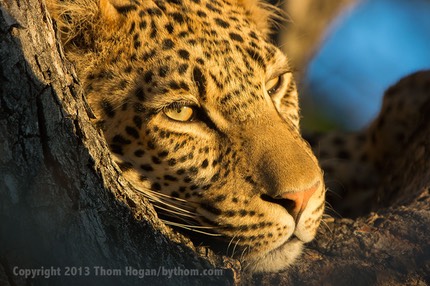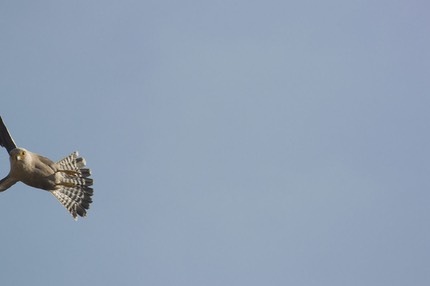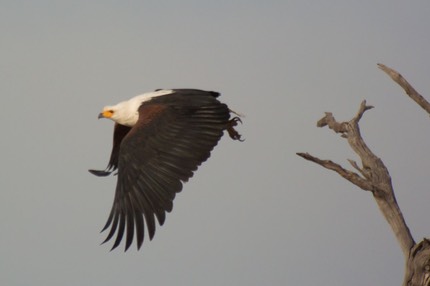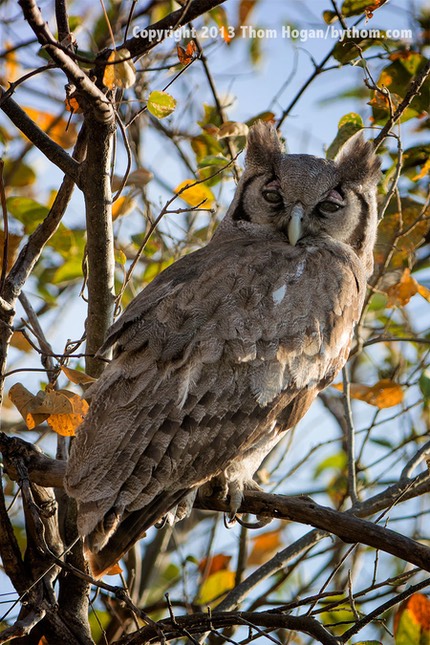We had quite a few Nikon 1 cameras at my recent Botswana photo workshop. Both me and my assistant were carrying V1 and V2 cameras, and many of our students had one or the other of those models, as well.
Here are some of the things I learned (or had reinforced) during the trip:
- Lens Choice — Yes, it makes a difference, even on the 1" sensor and only 14mp max. One reason so many of us brought along Nikon 1 cameras was that our main cameras were Nikon DSLRs. With the FT-1 adapter, the Nikon 1 cameras can use regular F-mount lenses and now perform continuous autofocus with them (though only in the central area). This makes them small and light backup solutions to bring on safari.
I'm about to take back something I wrote previously, so pay attention!
The 70-200 f/2.8, 70-200mm f/4, and 70-300mm f/4-5.6 are all natural selections for safari use with the Nikon 1 cameras, as you get 540mm and 810mm equivalent out of them, respectively. Previously, I had opined that the 70-300mm was probably the best hand-held solution with the Nikon 1. After doing a number of comparisons in the field, I'm going to take that back: the 70-200mm f/4 is the best choice that balances size versus performance. There was a clear "snap" to the 70-200mm that wasn't quite there in the 70-300mm images (even those taken at 200mm), even wide open. And you can use every bit of extra aperture on a Nikon 1 to keep ISO down, even if it's only a part of a stop. The 70-300mm isn't a dud on the Nikon 1—it's still pretty darned good—but the 70-200mm f/4 was better. Clearly better. Why not the 70-200mm f/2.8? Well, okay, that extra stop is really nice, but you're gaining weight and size to get it. The 70-200mm f/4 on the V2 proved to be a hand holdable combination that wasn't fatiguing, was well balanced, and performed great. It's my new recommendation for an all-around portable "reach" solution.
And if I thought the 70-200mm was good, the 200-400mm and 500mm were better. Not necessarily better in terms of acuity, but considering that you're getting 1080mm or 1350mm equivalent, just down right impressive reach with clarity. As in the following photo (this is the full, uncropped frame; there'll be a variation of this shot I like even better taken with this combo on the workshop blog when I post it later this month):

1080mm puts the leopard pretty darned close. Humorously, another vehicle pulled up just behind us and I turned to see someone taking this same shot with their iPad. Love to compare our photos ;~)
- Battery Life — Bring plenty of extras. Between the EVF and the fact that VR remains powered on constantly when the camera is on (assuming VR is turned on at the lens; see next point), you can drain batteries fairly quickly with the Nikon 1 models. Which is a bummer, as I'm convinced that there is a flaw in the V1's firmware: EN-EL15 batteries age quicker on a V1 than they do on a D800. I've now had the chance to verify that in practice by isolating new batteries: the same number of charge cycles on a V1 produce faster aging than does the D800. Considerably faster, as in reaching 4 within months of use on a V1 while the same batch of battery is still at 1 on my D800. Nikon denies this can happen. It does, and I'm not the only one that's discovered it. The sad problem is that the V1 will refuse to use a battery aged 4, while the D800 will continue to use it just fine (and seems to show no degradation of number of shots that can be produced with that battery). The V2 doesn't seem to have this same problem (though it uses a different battery).
- VR — The temptation is keep VR set to On. After all, you may be hand holding a 810mm or more equivalent lens and you want to keep ISO down as low as possible due to the small sensor's propensity for noise at high ISO values. Unfortunately, if you're shooting continuously (as opposed to single frames), you want VR turned Off. Always. Why? I can't tell if the system is not always re-centering the VR elements correctly or if the re-centering is just excessive due to the high magnification, but the problem is simple: with VR left On you'll get a jumping viewfinder. It becomes extremely difficult to follow action with VR turned On. Misframed shots with missed focus tend to be the result. Turning VR Off solves the problem. Otherwise you risk getting shots like this in your sequence:

Hey, how come that guy can't follow me?
- Settings — It seems pretty clear to me that no one at Nikon really shoots much with their cameras any more. Either that or they just ignore basic design issues that come up during shooting with the prototypes. One simple example that virtually every safari user of the FT1 and F-mount lenses will encounter: you can assign AF Lock to the top of the Direction pad on the V2, sort of a poor man's inverse AF On. Not only can you, but you'll want to, because otherwise focus is always done at the center of the frame which is going to restrict your framing considerably. That's okay if you're in Single Servo autofocus and can reframe after focus is acquired, but consider the classic "bird on a stick" shot where you want to also be able to get the bird framed right on the stick while still having a chance to get the bird in focus after it leaves the stick. That's a situation AF-On was invented for, and at least with AF Lock we can attempt to mimic that function. Great. So now try this in practice. Lock focus on the stationary bird and reframe. Get ready unlock focus as the bird flies. It's awkward at best, and I find that I "miss" getting focus locked and unlocked when and where I want it a lot. In the "bird on a stick" to "bird leaving stick" transition I often simply missed getting the focus back in time (see below). AF On buttons tend to be up where you right thumb naturally falls for a reason. Hey, right about where the F button is. Which I can't program.
While the change to the Mode dial between the V1 and V2 was welcome, it still tends to move in rough handling in a safari vehicle when I'm not looking. But the other unwelcome handling aspect is that exposure compensation is controlled with the right side of the Direction pad, and in trying to handle the V2 with big lenses, I found that I was often hitting that with the palm near the thumb of my right hand when I didn't want to.

Right timing, wrong focus. Happens more than it should with the design restrictions of the Nikon 1 cameras.
- Readiness — But my biggest gripe has to be about "readiness." We don't have a lot of flexibility here. The camera will go into standby after 60 seconds of inactivity unless you set that value to 5 or 10 minutes, which just drains the battery more. Coming out of standby to take a photo takes about 2 full seconds. Worse still, the power switch around the shutter release is easy to accidentally hit when you're bouncing around the tundra. The combination of these things means that there were plenty of times when I wanted to take a picture where I missed the moment, a fatal flaw for a still camera. That led me to increase my power consumption by increasing the standby time (see "Battery Life," above).
- Ruggedness — I didn't coddle my V2 (or my V1). No LCD protector, no rubber casing, no baggie over it while not in use in the dusty Kalihari Desert. Most of the time, the camera was not in a bag, even at night, where I simply put it down on the floor of my tent so it'd be handy if anything walked into camp. The good news: my V2 still looks like new and seems to have suffered no ill effects of being dragged halfway across the globe and abused for three weeks. About all I did was dust it off periodically. The V1 is even more rugged than the V2 (other than the darned Mode dial that moves when you're not looking), and didn't really even need dusting (not a lot of small controls for dust to get caught in).

Nikon V2, 240mm (648mm equivalent; shot on 200-400mm), f/4.5, ISO 160. This is the full frame, no cropping. Bottom line: you can bring back very good shots with the Nikon V2 and a good F-mount lens. Consider that this same shot on a D300 would have required the 400mm f/4 lens, and probably wouldn't have been any better.
Here's the thing. I (and others) long ago learned that the Nikon 1 is a darned good and flexible substitute for a compact camera. Especially for someone with F-mount lenses, as these cameras can also serve as a remarkable telephoto tool. Nikon charges an arm and a leg for these cameras—more than many of their DSLRs, at least when the Nikon 1's aren't on deep discount to unload inventory. Nikon wonders why these cameras get maligned in reviews, forum comments, and other places online. Well, it's simple, really:
1. They're simply not showing the world what these cameras are capable of.
2. They've put too many design compromises into them, which keeps serious photographers from easily getting what the cameras are capable of.
3. They don't acknowledge real flaws (that fast battery aging, for example).
4. They seem more focused on Ashton Kutcher, attracting women, the colors of the cameras, and how big the "1" is on the front of the camera rather than on what the camera actual does.
I still like the Nikon 1 models with EVFs very much. But Nikon doesn't make liking them very easy.
I'll reiterate an offer I've made before: I'll make room at one of my workshops for free for any Nikon engineer whose responsibility is the usability of Nikon interchangeable lens cameras. I'll show him (it almost certainly is a him, unfortunately) just what's getting in the way of taking great shots, and what would fix that. Heck, I'll go to Japan and do a workshop there just for Nikon engineers if I need to. What frustrates me is how close they come to getting so many things right, but the fact that they simply repeat so many common design mistakes.
Nikon's not alone in this problem, so don't think I'm picking on them. It's just that I'm mostly using Nikon gear (with a splash of Olympus) in my work, so I'm most familiar with the Nikon products and how they're not performing as well as they could.
(More shots from me and my students from my recent Botswana photo workshop will appear on dslrbodies.com at the end of this month when I turn on my time-delayed daily blog from that trip.)
